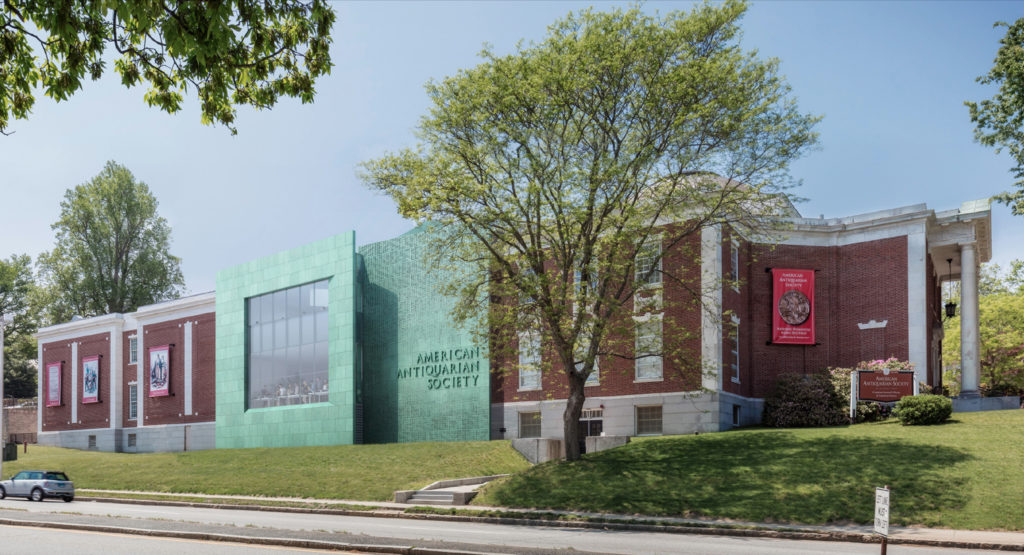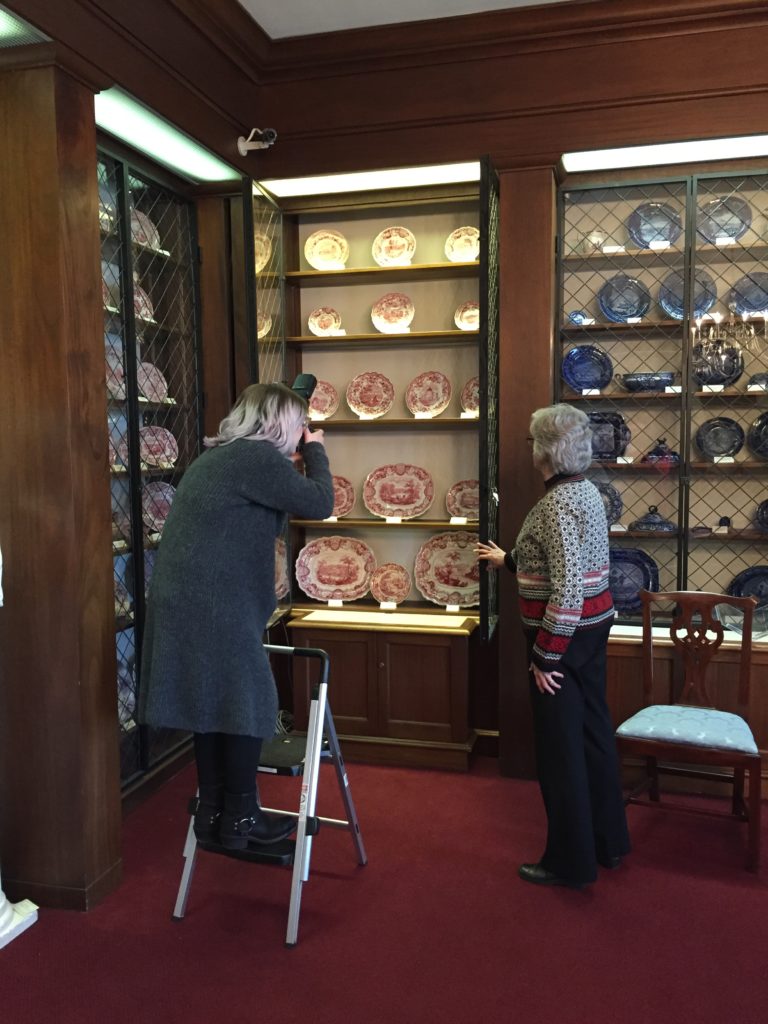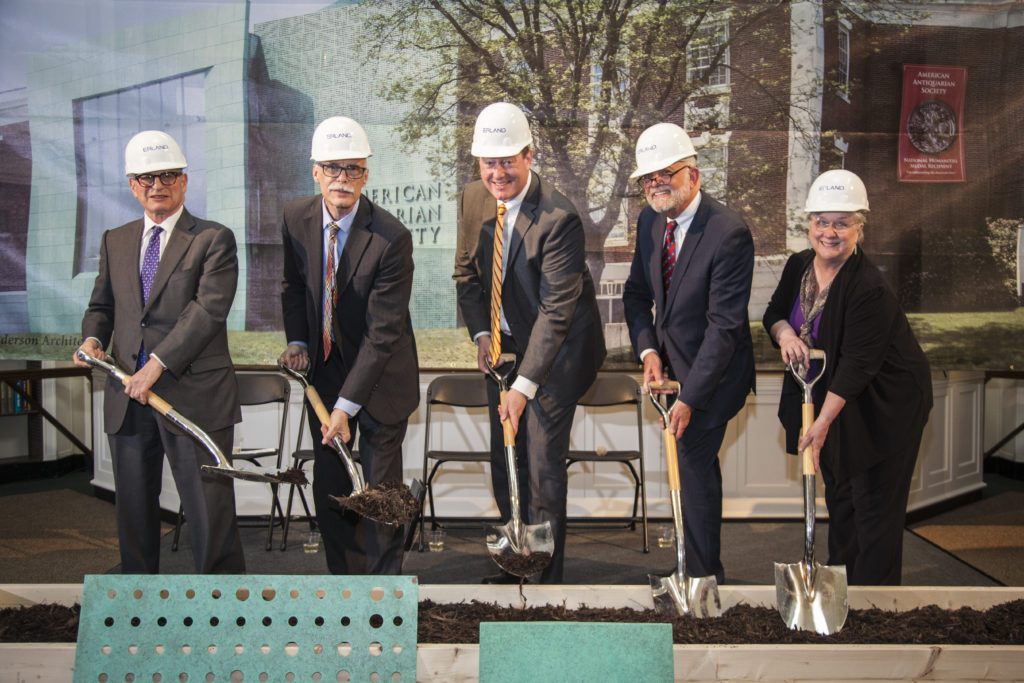After months of preparation that included shifting stacks, boxing up objects, and countless meetings about architectural plans, the ground has finally been broken—both figuratively and literally—on the expansion and renovation of Antiquarian Hall.

The Preparation
As with any major building project, much of the time in the months preceding the actual construction was spent on refining and finalizing the architectural plans. Meetings with architects, contractors, and various staff members have been a constant presence here at AAS. But beyond the blueprints, there are also a lot of other preparations that need to be done when renovating and expanding an over-one-hundred-year-old building with over four million items residing in it. Two of the biggest projects involve removing various artwork and collection items on display and shifting collection material in the stacks to make room for the renovation work.
Though AAS’s collecting focus is on printed material and manuscripts, as anyone who has been on a tour can attest there is also a substantial amount of artwork as well as interesting artifacts on display around Antiquarian Hall. Portions of our large portrait collection line the walls of Antiquarian Hall; Isaiah Thomas’s first printing press, Old No. 1, has a permanent home on the balcony; and a collection of nineteenth-century Staffordshire pottery nestles comfortably on the shelves of the Council Room (now renamed the Thomas Room in the course of this building project). All of these items need to be protected from the vibrations and other movement caused by the construction of the addition.

The Emma DeF. Morse Collection of American Historical Pottery, which has 324 pieces of nineteenth-century Staffordshire pottery illustrating major sites in the United States and commemorates events in the nation’s past, was the first collection to be put away for safekeeping. Each case was photographed in situ before being packed away by a professional art handling company with the help of Lauren Hewes, our curator of graphic arts, and Nan Wolverton, our director of fellowships and the Center for Historic American Visual Culture (CHAViC). Other small but popular items, such as the vial of tea from the Boston Tea Party and the Celeron Plate, have been temporarily moved and put on display in the Orientation Room off of the front foyer of Antiquarian Hall. In mid-June, the portraits currently hanging on the walls will be removed and Thomas’s printing press will be boxed up for protection. (Due to the removal of these items and other construction-related restrictions, we will be temporarily suspending our weekly Wednesday afternoon public tours after June 14.)

The other large undertaking—shifting collection material in the stacks—was a long and complex task, but necessary to the success of the project. With so many collection items housed within the walls of Antiquarian Hall, it was a challenge to figure out how to keep the collections here—thereby allowing minimal impact on library operations—but still maintain proper levels of safety while giving the contractors room to renovate the HVAC system. With their usual precision and doggedness, library staff have managed to shift and consolidate collections within the existing stacks to provide enough room for the contractors to safely complete their work. In total, nearly 10,000 shelves of material were shifted during the process.
The Groundbreaking
While these preparations have been ongoing, AAS also planned a Groundbreaking Ceremony, held in the Reading Room on April 27. With remarks by AAS Council Chair Sidney Lapidus, AAS President Ellen Dunlap, AAS Council member James Donnelly, project architect Samuel Anderson, and Worcester City Manager Edward Augustus, and a champagne toast for the standing-room-only crowd, it was a celebratory event marking the beginning of the construction phase of the project. Chairman Lapidus also announced that more than $9.5 million has been raised to date towards the $20 million goal for construction costs, a sum that reflects the first part of our “Safeguarding the American Story” campaign.

It was a bit unusual for this antiquarian crowd to have a trough of mulch in the Reading Room, but if ever there were a proper occasion, this was it! Samples of the pre-patinated copper that will be used to fabricate the new Park Avenue façade and screens showing the architectural plans of the building were also on view.

The Construction
With the planning, preparation, and pleasantries under our belt, we’re now ready for the construction phase of the project. Work has already begun on building a new, specialized server room within Antiquarian Hall. The work trailer for the construction crew is in the parking lot, and the construction fence has been erected. 3D imaging that the engineers will be using to plan out the placement of the new HVAC ducts is being completed. Digging and drilling related to the building of the expansion portion of the project has also begun.
As construction continues in the coming months, we’ll be providing regular updates about the progress here on the blog, as well as on our website. For more details about the goals of the building project, check out the September 2016 and March 2017 issues of our newsletter, Almanac. Upcoming issues of the newsletter will also feature more information. And as the project nears its end in the fall of 2018, we look forward to sharing with you not only the physical building, but also the exciting new possibilities that its completion will bring to the Society. We hope you’ll follow us on this journey!


One thought on “Construction Begins On Antiquarian Hall”